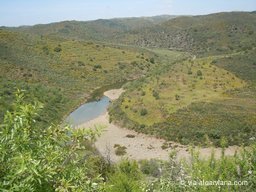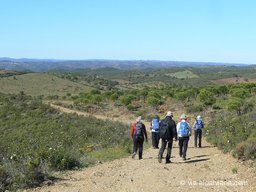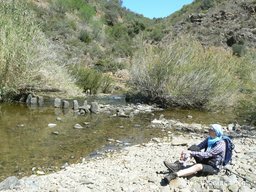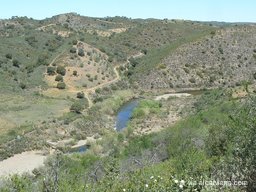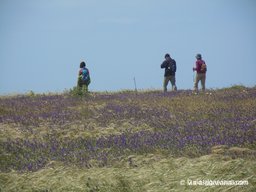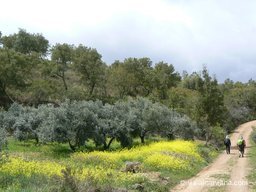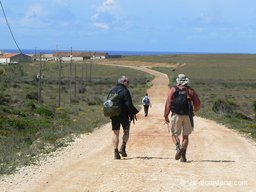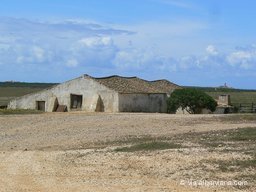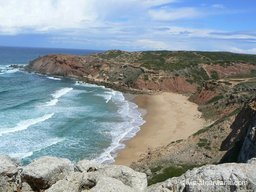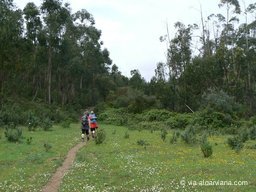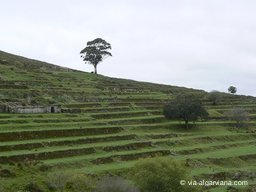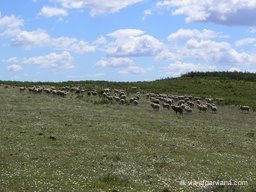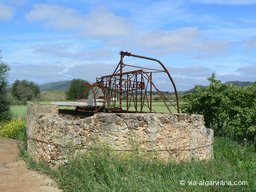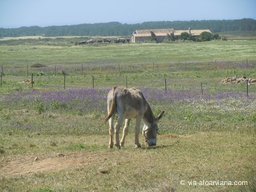My Via-Algarviana
Music: Stefan Krawczyk)Every walk begins with the first step. The first time, we take two weeks off. We divide the route into three legs, each taking four or five days. We walk through oceans of blossoming cistus, find shade under centuries-old cork oaks, and observe eagles circling majestically. The scent of rosemary, orange blossom and wild orchids accompanies us. The pastures and meadows are still green in spring, and shepherds roam over the hilly grasslands with their sheep and goats. We aim to cover between 15 and 42 kilometres daily. Only nature and the infrequent accommodation opportunities guide us every day of the walk. On the first five days, we cover about 114 km through the central uplands of Portugal.
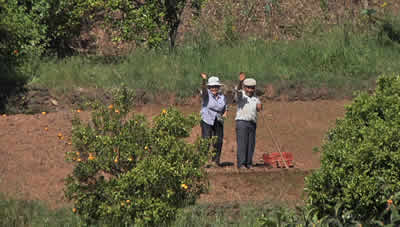 We reduce our speed and discover our innate slowness. The natural surroundings are so wonderfully quiet: no motors, no telephones ringing, none of that endless hum of the big city. We can only hear the bees buzzing, observe wild boar, snakes, geckos and chameleons. Nightingales keep us company for many kilometres. On one occasion early in the morning, there’s a cracking sound in the undergrowth. We stop and listen excitedly into the half-light that heralds the sunrise. Suddenly we see them. Two adult deer, standing still next to each other and watching us. Several minutes pass in this way. Not even ten metres away from us, they look into our eyes and we into theirs. Without any of us moving, our gazes meet. What must they be thinking about us? They show no fear or timidity. They appear curious. Then some wild dogs come shooting round a bend in the path and the magic of the moment is shattered by panting and barking. We have never seen deer in the uplands of the Algarve. Standing protectively in front of the two animals, we shoo the pack of dogs away with our hiking staffs. They hadn’t reckoned with us. For a moment, they slowed down, appeared rooted to the spot, appeared to waver between attack and defence, evasion or biting… they were undecided for a moment. A raised stick did the trick. Once the little wolves had withdrawn, we realised that the deer had also disappeared without a trace, as if they had never been there.
We reduce our speed and discover our innate slowness. The natural surroundings are so wonderfully quiet: no motors, no telephones ringing, none of that endless hum of the big city. We can only hear the bees buzzing, observe wild boar, snakes, geckos and chameleons. Nightingales keep us company for many kilometres. On one occasion early in the morning, there’s a cracking sound in the undergrowth. We stop and listen excitedly into the half-light that heralds the sunrise. Suddenly we see them. Two adult deer, standing still next to each other and watching us. Several minutes pass in this way. Not even ten metres away from us, they look into our eyes and we into theirs. Without any of us moving, our gazes meet. What must they be thinking about us? They show no fear or timidity. They appear curious. Then some wild dogs come shooting round a bend in the path and the magic of the moment is shattered by panting and barking. We have never seen deer in the uplands of the Algarve. Standing protectively in front of the two animals, we shoo the pack of dogs away with our hiking staffs. They hadn’t reckoned with us. For a moment, they slowed down, appeared rooted to the spot, appeared to waver between attack and defence, evasion or biting… they were undecided for a moment. A raised stick did the trick. Once the little wolves had withdrawn, we realised that the deer had also disappeared without a trace, as if they had never been there.
The path leads us down to the Foupana and Odeleite rivers – the place for a nice swim – and up again into the Serra do Caldeirão. On the third day the rain starts. For hours, we trudge along wet, muddy paths. Streams burst their banks. We are dripping wet and freezing long before we have reached our lodgings. Overnight, the wind direction changes. The next day, the scorching sun and agonising heat that accompany us for many hours a day have returned.
According to what laws have we learnt to spend our lives? How would we behave if we suddenly realised that we had gone in a completely wrong direction? Should we simply return to the crossroads where we turned on to the wrong path? To which of the many crossroads? Or should we just keep wandering on in the hope that we will some time stumble upon the right road again? Which crossroads was the right one, and which path? There was doubtless only one right answer. And so, what would happen if you kept going and really had found the right path – or what could we do if we had moved further and further away from the path and had got more and more lost? Turn around, possibly?
In the interior during the first few days, we come across no hotels, no supermarkets and no car rental firms - and – no tourist information offices. We encounter people who live with this natural world day in day out: wine growers and shepherds – we encounter a traditional agriculture that lives from what is sown and harvested. Hard work. In this way, we reach Cachopo, uphill, and the next day Cortelha, the watershed between east and west….
… Here it is possible to see the hills of Monchique for the first time. It is another 106 km from Cortelha to Monchique.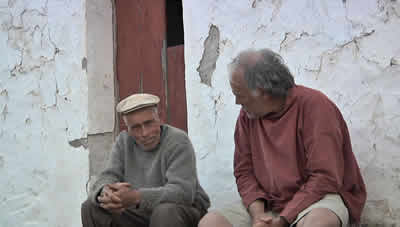 The path continues via Salir and Alte to Silves. The Moorish influences in architecture and agriculture become noticeable. The springs and irrigation systems of the Muslims accompany us; although they are no longer operational in most cases. More people meet the hikers. The old people are mostly friendly and recall the times when everyone used to walk or transport the harvest by donkey.
The path continues via Salir and Alte to Silves. The Moorish influences in architecture and agriculture become noticeable. The springs and irrigation systems of the Muslims accompany us; although they are no longer operational in most cases. More people meet the hikers. The old people are mostly friendly and recall the times when everyone used to walk or transport the harvest by donkey.
Figs, almonds, olives and mulberries, here and there carob, almost everywhere oranges and lemons, medlars, peaches and here and there mangoes and avocados too. The middle of the Algarve is the most fertile region, also known for the best honey in the country. In Bensafim, we come across the biggest and oldest holm-oak on the path. It has space for a breather and we rest at a table under its huge boughs. We walk past a restored wash-house, and again jump over a stream whose waters roar towards Alte. In spring, the countryside is in full bloom. April is the most beautiful month for a hike in the south-west of Europe: lavender, rosemary, thyme, sage, lemon cress and many other herbs sprout from the ground and thrive; wild orchids too, lilies, peonies.
On the ninth day, we begin our ascent into the hills. Ruins, wherever you look. We walk through a fairy-tale, through a land that has been forgotten. Now we’re at Fonte Santa close to the Odelouca river. We bathe in warm water. Apparently it was here in 1495 that King DOM JOÃO II took his last bath before he died in Alvor (near Portimão). But we hope that nothing similar befalls us. Our path does not appear on any maps. The official Via Algarviana path has been different for a long time. From now on, we hike along the old pilgrims’ path of Saint Vincent. The tarred surface of the official route is not to our liking, so that, over the years, we have sought out other, old, sometimes historic paths that we rebuilt with farmers and shepherds.
My Via Algarviana always veers away from the official route where civilisation and its illnesses disturb the natural surroundings. We seek out paths that don’t appear in any catalogue. Why don’t you build your roads and your houses around the trees and woods, instead of tearing up whole forests, tarring nature over with oil, purely so that your cars roll better? Why do you erect your concrete houses where there used to be trees? Maybe you don’t even think about it, because your senses have become blunted. You accept this as natural. Maybe you plant another tree as an accessory, as a decoration facing the road in front of the house, and decorate flower-beds in the city, and why? Because nature is missing from your lives. But you will always give priority to a car or a house rather than a forest or a tree. And do you notice something? The only people to notice such things are those who travel on foot…
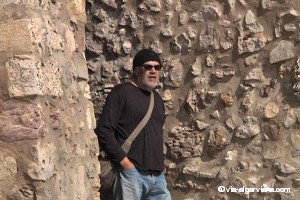 … In the hills, we encounter brandy distillers, olive farmers and wood cutters. We visit the last olive presses in Pardieiros near Monchique. From the peak of Picota, at a height of 776 metres, we can already glimpse the south-west cape. The final third: 108 km. Coming down from the uplands, we cross the countryside down into a region where there are only few inhabitants per square kilometre over the last kilometres. Here we are still able to find what we’re actually looking for, peace, and the possibility of being completely alone and at one with oneself and with nature during a walk. Some people call it meditation. Others are afraid of getting involved with this kind of nature. And so anyone who is looking for this strength and is able to walk the 328 km in 15 days, should mentally adjust to their Via Algarviana for at least a day in Alcoutim on the banks of the Guadiana. At the end of our walk, between Vila do Bispo and the south-west cape, we visit a friend again every year, the shepherd. Another six shepherds also share this moorland for their flocks to graze on. We drink a glass of fresh goat’s milk. Delicious. This is where thefilm “Revolutionary Roads” ends, and the book with the same name; in conversation with the shepherd Manuel António Violente and his view of things.
… In the hills, we encounter brandy distillers, olive farmers and wood cutters. We visit the last olive presses in Pardieiros near Monchique. From the peak of Picota, at a height of 776 metres, we can already glimpse the south-west cape. The final third: 108 km. Coming down from the uplands, we cross the countryside down into a region where there are only few inhabitants per square kilometre over the last kilometres. Here we are still able to find what we’re actually looking for, peace, and the possibility of being completely alone and at one with oneself and with nature during a walk. Some people call it meditation. Others are afraid of getting involved with this kind of nature. And so anyone who is looking for this strength and is able to walk the 328 km in 15 days, should mentally adjust to their Via Algarviana for at least a day in Alcoutim on the banks of the Guadiana. At the end of our walk, between Vila do Bispo and the south-west cape, we visit a friend again every year, the shepherd. Another six shepherds also share this moorland for their flocks to graze on. We drink a glass of fresh goat’s milk. Delicious. This is where thefilm “Revolutionary Roads” ends, and the book with the same name; in conversation with the shepherd Manuel António Violente and his view of things.
Because the young people leave their own villages and their families without this knowledge and they forget their traditional origins. Almost all of them now live on the coast or in the conurbations like Faro and Lisbon – or they have emigrated, following the scent of money and progress.
Despite everything, the story-teller is filled with hope and joy. It is the hope and joy one finds during the long walks. Because you can write lots of good stories, or simply tell them to yourself. Stories of succeeding. They are the life stories of people and their work, of their handicrafts: of potters, tinkers, shoemakers and cartwrights and the blacksmith, from the felting of clothes to the knotting of rugs from flax, of farmers, beekeepers and shepherds. Knowledge that does not get lost in the whirl of modernity. At some stage, we met the first young person on our walks. He told us that he had had enough of the city, that the future lay in nature and in our dealings with it. How naturally he stands there beside a stream with his goats that are grazing there, telling us about his two horses and the garden that he cultivates. Work that brought meaning into his life.
With the south-west cape, the old end of the world, in sight, we can smell the sea and can already hear the surf. The hikers’ many blisters and the nightly cramps in their calf muscles have been worth it. This arduous route was walked for the first time in the fourth century, according to a piece of information in a leaflet from the Diocese of Faro. Legend has it that the ship carrying the bones of St Vincent of Valência ran aground on the cape near Sagres and two ravens rescued the human remains from the water. The old pilgrims’ footpath from Alcoutim to the south-west cape becomes a journey through time and tradition. Incredible what two legs can achieve …
My Via Algarviana: Alcoutim • Vaqueiros • Cachopo • Feiteira • Cortelha-Salir • S.B. Messines • Silves • Caldas de Monchique • Monchique-Marmelete • Aljezur • Arrifana • Carrapateira • Vila do Bispo • Cabo S. Vincentenext hike from 30-4-2022 until 14-5-2022.
Excerpt of ECO123 Edition 28 page 3
Dates and further information in the PDF file
Request now to: info@via-algarviana.com
